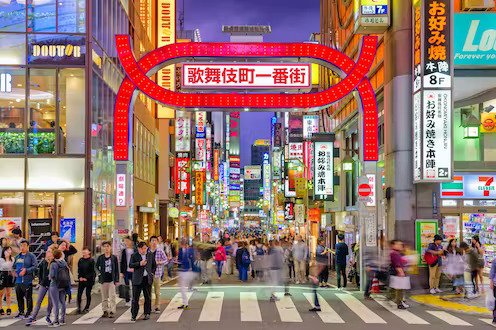On the afternoon of October 16 last year a brawl erupted between two groups of gangsters in a restaurant on the 58th floor of the Sunshine 60 high-rise building in Ikebukuro, a central neighbourhood of Tokyo. A group of around 70 people crashed a private party and fighting broke out, resulting in one person bleeding from the head and sustaining minor injuries.
The Tokyo police subsequently revealed that the party had been held by members of a criminal group known as the Chinese Dragons. The Dragons were celebrating the release from prison of one of their leaders and were attacked by a rival Chinese gang.
There is increasing concern in Japan that the Chinese Dragons – or other criminal groups that have moved from China in the past 30 years – are infiltrating the Japanese criminal underworld that used to be controlled by the indigenous mafia, the yakuza.
The Chinese Dragons originated in the 1980s in Kasai (Tokyo). One of the founders recounted that it started to protect himself and his friends from the rampant discrimination against people of Chinese descent. Indeed, many of the members are “Chūgoku zanryū koji”, children and grandchildren of Japanese nationals who had been left behind in China at the end of the war, and returned to Japan as adults after the normalisation of the relationship between China and Japan. Their influence and activities remain local.
Contrarily, the yakuza are a confederation of criminal syndicates active throughout Japan. According to Japanese law, their status is not illegal: they have offices and a yakuza presence is still noticeable in many cities.
The yakuza have been described as a “necessary evil” – while their involvement in criminal activities has always been recognised, their ability to monopolise and control the underworld, curbing the excesses of less-organised gangs and foreign groups, was seen as reassuring. Their relatively irregular use of violence and the stress they put on following a traditional chivalrous moral code meant that for a long time they have been, if not accepted, somehow tolerated.
Until the 1990s, they also had a favourable relationship with the police, which was able to make direct requests to the heads of the groups. The most famous example is the visit of US president Dwight Eisenhower, during which yakuza and other paramilitary forces were enlisted by political fixer Kodama Yoshio to support the police.
But things changed. New severe anti-yakuza laws were introduced in 1992: (Bōtaihō) and 2011 (Bōhaijōrei) – which effectively forced the yakuza underground – and a prolonged period of economic stagnation in Japan led to a decline of the yakuza. Membership has reduced from more than 80,000 in 2009 to less than 23,000. They also seem less able to maintain a monopoly of Japan’s criminal underworld – allowing gangs like the Chinese Dragons to step in.
The public perceives non-yakuza groups to be more violent and lacking a moral code. Gangs based on ethnic kinship (notably Iranian, Nigerian and Chinese) have been active in Japan since the 1980s. But the yakuza has always managed to keep them under control.
There have been exceptions to this which have resulted in violent clashes between the yakuza and Chinese gangs from time to time. In 2002, Chinese gang members shot two yakuza in a busy night-club called Parisienne in the Kabukicho area of Tokyo, which is famous for its nightlife. The yakuza were asking the Chinese gang for a fee to allow them to operate in the area. According to Hirosue Noboru, one of the few experts on organised crime in Japan, some yakuza groups subsequently issued a warning to their members not to get involved with the Chinese mafia, because of their penchant for violence.
An internal feud in the 1980s – the Yama-ichi kōsō – which broke out between two yakuza gangs, the Yamaguchi-gumi and the Ichiwa-kai, resulted in 29 deaths and hundreds of violent confrontations. It was brought to a close by a peace deal brokered by another large yakuza clan, the Tokyo-based Inagawa-kai. But the severity of the violence led to the introduction of more severe anti-yakuza laws in 1992.
In comparison, the methods of Chinese mafia groups have always been more violent and have been more likely to involve civilians, often via extortion of shopkeepers and bar owners.
This town’s not big enough
It is not possible for two competing groups to operate in the same territory without bumping heads. “There are occasions in which dealing with them is just inevitable” the boss of an influential yakuza group in Tokyo told me recently. Non-yakuza groups can pay a fee to gain the right to operate in the underworld, showing that the yakuza is still able to regulate the illegal market.
But given their reduced strength in terms of member numbers and streams of income, the yakuza’s need for money is increasing. And some yakuza groups might be forced to accept the activity of an unreliable external group, such as one of the Chinese gangs, to get the protection money.
As yakuza membership declines and those remaining grow older, they might have to accept more disadvantageous deals when negotiating with competition, since their ability to intimidate through violence is diminished.
The name of the Chinese Dragons is becoming more notorious, due to news coverage of incidents such as the Sunshine 60 brawl. But, according to a Tokyo yakuza boss I spoke to recently, the increase in popularity does not mean they are growing more influential. Chinese groups are a long way from taking over the Japanese underworld, which remains controlled by the yakuza.
The Japanese media has tended to exaggerate the threat posed by the Chinese Dragons – and the Chinese mafia in general. It’s a fear that plays on broader social anxieties in Japan concerned with the rise of China taking over. Anti-Chinese discrimination (also directed at Koreans) is common and goes back before the second world war. But it should not mask the reality that, for the foreseeable future at least, the yakuza still runs Japan’s criminal underworld.



 How to support someone who is grieving: five research-backed strategies
How to support someone who is grieving: five research-backed strategies  AI is driving down the price of knowledge – universities have to rethink what they offer
AI is driving down the price of knowledge – universities have to rethink what they offer  6 simple questions to tell if a ‘finfluencer’ is more flash than cash
6 simple questions to tell if a ‘finfluencer’ is more flash than cash  Why have so few atrocities ever been recognised as genocide?
Why have so few atrocities ever been recognised as genocide?  Canada’s local food system faces major roadblocks without urgent policy changes
Canada’s local food system faces major roadblocks without urgent policy changes  Locked up then locked out: how NZ’s bank rules make life for ex-prisoners even harder
Locked up then locked out: how NZ’s bank rules make life for ex-prisoners even harder  Disaster or digital spectacle? The dangers of using floods to create social media content
Disaster or digital spectacle? The dangers of using floods to create social media content  Columbia Student Mahmoud Khalil Fights Arrest as Deportation Case Moves to New Jersey
Columbia Student Mahmoud Khalil Fights Arrest as Deportation Case Moves to New Jersey  Asian Fund Managers Turn More Optimistic on Growth but Curb Equity Return Expectations: BofA Survey
Asian Fund Managers Turn More Optimistic on Growth but Curb Equity Return Expectations: BofA Survey  Why a ‘rip-off’ degree might be worth the money after all – research study
Why a ‘rip-off’ degree might be worth the money after all – research study 
































